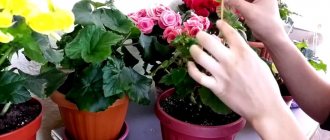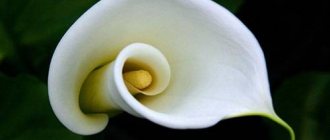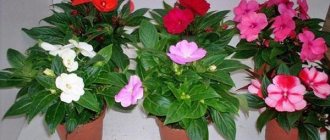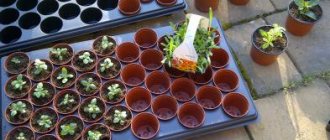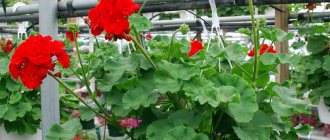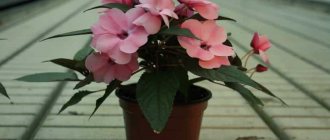Why do you need to prepare in the fall?
Begonia is an ornamental flower grown both outdoors and at home.
Reference. From the beginning of November until the last days of February, the plant falls into a dormant state, in which it regains its strength after the end of the growing season.
Dormant period and awakening of tubers
If you do not follow the rules for storing tuberous begonia in winter, then in the spring, due to the insufficient number of buds laid by the tubers, the plant will bloom poorly. To preserve a perennial, you must adhere to a number of rules:
- Young bulbs grown from seeds require a cool place, moderate light and infrequent watering. It is not necessary to dig them out of the pot; simply cutting off the above-ground part will be enough.
- large tubers of indoor begonias are left in pots and placed in a cool place. In this case, when trimming the dried ground part, leave 1 to 3 cm.
- Begonias growing in open ground are dug up after flowering and placed in storage under special conditions. At the end of the dormant period, planting material is removed from storage and begins to be prepared for germination.
In March-April, after the buds of the flower swell and it comes out of its dormant state, cuttings are carried out and the begonia is planted in a peat mixture. Two months before this procedure, the tubers are removed from the container in which they were stored and planted in a container for the purpose of germination.
It is permissible to divide the tubers into several segments, the main thing is that each of them contains several buds. Places of cuts and cuts are treated with charcoal or ash.
Important! Sprouted begonia should be planted in open ground at the end of May or early June.
Germination of tubers in sphagnum
Having sprouted begonia in sphagnum at least once, you are unlikely to want to return to the classic version described above. The algorithm of actions is as follows:
- Place a five-centimeter layer of sphagnum moss in a container and cover with a clean cloth;
- thoroughly moisten and drain excess water;
- place the tuber bulbs on the surface;
- wait for the first shoots and care in the same way as when germinating in the ground.
Germination of tuberous begonia in sphagnum.
Highly hygroscopic material retains moisture for a long time, kills pathogenic bacteria and fungal infections. In this case, the question: what is the best way to soak begonia tubers before planting becomes irrelevant.
How does a plant overwinter in an apartment and in open ground?
Caring for tubers of plants growing in the garden and at home has significant differences. To properly prepare them for winter, you need to know the characteristic features of each variety.
The maintenance of perennials growing outdoors is as follows:
- Flowers are removed from the street after the first serious frost. You should not rush to dig up tubers when the temperature drops slightly, since such conditions are not capable of harming them. The plant needs to be given the opportunity to gain strength and prepare for the dormant period.
- After the flower's stems and leaves die, they are cut off.
- The tubers removed from the soil are placed in a box and allowed to dry thoroughly.
- Containers with planting material are put away for storage until spring.
Care for begonia growing at home is carried out somewhat differently:
- There is no need to dig up the tubers: the plants remain overwintering in their pots.
- After the stem and leaves begin to fade, they are cut off.
- From this point on, the frequency of watering is reduced to a minimum.
- The container with the flower is placed in a cool place.
- To prevent the soil from drying out completely, moisten it regularly.
- In the spring, the begonia must be transplanted into new soil. Before the procedure, the plant is divided into several segments in case of formation of a large number of buds.
In some cases, the plant remains green and does not shed its leaves throughout the winter, then it is left untouched until spring, and only then is replanted.
Attention! When purchasing indoor begonia in the last days of summer, you need to check whether it has tubers, since there are annual varieties.
The video below describes the nuances of preparing indoor begonias for winter:
Preparation for storage
Before storing begonia tubers, even before harvesting them, you should perform the following steps:
- you need to remove new buds and shoots;
- watering plants is reduced to a minimum;
- stems that have begun to wilt are saved to allow the tubers to ripen.
To ensure that storing begonias in winter does not result in the loss of planting material, it should be selected very carefully. Damaged and diseased tubers, as well as plants with dark spots on the leaves, are not suitable for storage. Also, you should not leave tubers that are too small (up to 4 cm) and dry with mold.
You need to dig up begonia bushes using a shovel or garden fork. This should be done very carefully so as not to damage the root system. The time to harvest tubers for storage is late autumn, when the first night frosts occur. In this case, the daytime temperature should be within the range of +8°C - +10°C.
Cold wind has a negative effect on plants, so at the first sign of darkening of the edges of the leaves, you need to start collecting tubers.
Before you start digging up the begonia, 3 - 4 weeks before, you should do the last feeding of the flowers. This is necessary to accumulate a supply of nutrients in the tubers. Feeding will allow the tubers to overwinter normally during the entire 3-4 months that are allotted for the dormant period of the flower.
Fertilizers for feeding should not contain large amounts of nitrogen and potassium. On the contrary, you need to use more fertilizers of animal origin.
Secrets of preparing a garden flower
In this procedure, it is important to find the golden mean when extracting tubers from the ground. Severe frosts will destroy the plant, but digging it up beforehand is not recommended. After the leaves and stems dry, the begonia bulbs begin to actively gain mass, and buds are laid for flowering in the next season. Extracting from the soil too early will significantly reduce the number of flowers during the growing season.
After the first signs of plant wilting appear, you must immediately stop watering. If begonia grows in a garden plot, it is recommended to cover the bush in rainy weather, preventing moisture from entering.
After the foliage turns yellow and falls, the stems are carefully trimmed with pruning shears, leaving stumps 2 to 3 cm high. After frost sets in, deal with the plant as follows:
- using a garden fork, remove the tubers from the soil so that the soil remains on the roots;
- the dug up bulbs are dried in a dry and slightly cool place (in conditions with high humidity there is a risk of rotting);
- placed in pre-prepared containers; paper bags or vegetable boxes are well suited for this purpose.
The air temperature during storage of planting material should be from +7 to 9 °C.
Preparing begonias for winter
At the beginning of autumn, all the buds need to be cut off from the bushes so that the begonia has time to accumulate nutrients in its tubers before the onset of frost, and does not allocate them to the growth and development of the buds. As soon as it accumulates the required amount of nutrients, it will immediately enter a resting phase, which will last until early spring.
After the buds have been cut, do not rush to dig up the begonia so that it has time to gain the mass of its tuber. In this state, it will survive the autumn frosts without any problems. But do not delay removing it until the first frost sets in. If you pull it out earlier, then next year significantly fewer inflorescences will bloom on the bush.
And from the moment the buds are cut, you need to reduce watering so that the begonia enters the resting phase. If the weather is rainy, cover the begonia with waterproof film.
But it happens that short-term frosts suddenly set in, and you did not have time to dig up the begonia, then there is no need to worry, in this case only the foliage freezes, and the tubers remain intact.
As soon as you notice the first signs of yellowing of the foliage, you can start digging it up. It is better to do this with a pitchfork or a sharp shovel so as not to damage the roots. As soon as the tubers are dug up along with a lump of earth, do not shake off the soil from the roots.
Then sort the tubers by size. Small ones in one container, large ones in another. It is not advisable to store them together, since small ones dry out more often than large ones. The tubers are placed close to each other.
After that, the begonia shoots are cut off with pruning shears, leaving about 3 centimeters on top, and their roots are cleared of any remaining soil. Then they are taken to a dry and well-ventilated room to dry.
The air temperature should not be lower than +14o, but not higher than +16o degrees. Let the tubers lie in this room for about two to three weeks, until their shoots completely dry out. It is better to dry them on cotton material.
After two to three weeks they are placed in boxes with peat or dry sand for storage until spring.
But experienced gardeners recommend mixing peat or sand with vermiculite, as it has heat-insulating properties and moisture-absorbing properties.
It can protect tubers from harmful insects and mice, and prevents root rot. It must be mixed with the substrate in equal proportions.
Next, the container with the tubers should be placed in a dark and damp room, where the air temperature does not exceed +10 ° C. Throughout the winter, you can occasionally water the soil so that the tubers do not dry out at all. This is only if the percentage of air humidity does not exceed 70%.
After the tubers have been stored for storage, you need to periodically check them throughout the winter for fungal diseases. If tubers infected with fungus are suddenly discovered, then in severely advanced cases they are removed, and mildly infected ones can be cured by treating them with brilliant green.
Features for first years
Reference. In the first year of life, the tubers of the plants are still quite small and weak, and therefore they require special care. If you leave them for storage in winter along with adult specimens, the risk of their death will increase significantly.
After the dormant period begins, young tubers are brought from the garden plot and, together with a lump of earth, placed in a container where the peat mixture has already been prepared.
The peculiarity of first-year children is that they do not fully fall into a state of sleep. It is not uncommon for the foliage and stems at the top to remain green throughout the winter. For this reason, the boxes with them are placed in a cool place with good lighting. Watering is not carried out at this time: lightly moistening the soil 1-2 times a month is quite enough. With the onset of spring, young begonias enter a stage of intensive growth.
In April, first-year plants must first be planted in peat pots, and closer to summer - in the ground.
In the second year of life, begonia independently prepares for the dormant stage, this is expressed in the death of its upper part.
What to do with Ampelous Begonia in the fall?
With the onset of autumn, watering the plant should be reduced. By the end of November, watering stops completely. The above-ground part of the branch will fall off (leaves) and dry out (stems), but there is no need to cut it. The tubers remain in the pot all winter and are stored at 10-15ºC.
Interesting materials:
How to make a voice like a Google guy? How to make the translator's voice male? How to make Siri's voice? How to vote in a WhatsApp group? How to vote in Stories? How to make a voice message? How to make voice chat in CS GO for everyone? How to make voice chat in cs go? How to make voice chat on Steam? How to make voice dialing?
Is it necessary to dig in the fall?
Since begonias are heat-loving plants, proper preparation for winter is of great importance for its further growth. Whether to dig up tubers for the dormant period or not depends on the type and condition of the perennial:
- large tubers growing in open ground are recommended to be removed from the ground after wilting and stored in a suitable container with peat in a cool place;
- large bulbs of indoor plants at all, leaving them in the same containers;
- flowers with small tubers and specimens sprouted from seeds are stored in a cool place with high-quality lighting.
Preparing tubers for storage
The result of storage and further growth depend on how correctly the planting material is prepared for winter and how you care for this plant.
Firstly, Begonias that grow in the garden must be dug up before the first hard frost . At this time, the upper part of the plant is cut off, leaving stumps no smaller than 1 centimeter in size.
Begonia tubers should be dried before storing.
Secondly, the tubers are put in a dry and cool place where they should dry out. Only after they are completely dry can it be put away for storage.
It is best to dig out the tubers with a pitchfork and under no circumstances should you shake off the soil from them.
Begonia, which grows at home , is stored differently. Preparations for hibernation begin in October. First, reduce watering, and after a month, stop it altogether. When the upper part of the flower fades, it is cut off. If it does not die off, leave it in its previous state.
Compliance with storage rules is the key to successful wintering and further growth in the future.
What to do to store the plant until spring?
Important! There are several options for properly storing begonias in winter. The most popular is the basement.
Well-dried perennial tubers are placed in suitable containers: wooden boxes, boxes. The planting material is sprinkled with sifted sand, and the container is removed to the basement.
Also, to make a mixture for the purpose of forming layers between tubers, you can use in equal quantities:
- peat;
- sand;
- sawdust.
This method is convenient for storing tubers in large quantities.
It is prohibited to lower the bulbs into the cellar, since high humidity will have a detrimental effect on the condition of the plant.
It is recommended to periodically inspect and immediately dispose of rotting specimens.
A place under a window or next to a balcony door is a good place to store tubers in an apartment. There are two methods of storage at home:
- in a box - the bulbs placed in containers are sprinkled with sawdust or sand;
- in pots - perennials growing in containers are cut off and left as is, installed in a cool place, and with the onset of spring they are transplanted into new soil.
In an apartment, begonia tubers can be stored in the refrigerator. This method is optimal only for a small amount of planting material. The bulbs are placed in plastic bags with pre-made holes and sprinkled with sawdust. In the absence of sawdust, you can wrap each tuber in plain paper and place it in the bottom drawer of the refrigerator intended for storing vegetables.
Attention! During storage, the tubers should be isolated from each other, which will reduce the risk of rotting.
If you follow all the rules of maintenance during the winter, next season you will be able to observe active growth and abundant flowering in begonias.
How to preserve young tubers
It is recommended to store young begonia tubers in winter in pots filled with moistened soil. Place several nodules in a pot and moisten the soil as it dries.
How to store begonia in winter:
- in the basement - at a temperature of 10 degrees and air humidity of at least 80%. “Adult” specimens will also overwinter here. They are placed in a box with a layer of sand and peat at the bottom. The tubers should not touch each other. The top of the “masonry” is covered with a storage mixture - vermiculite;
- in the refrigerator - dried tubers are placed in a bag with peat and vermiculite, holes are made for air; or packaged in a food container as for storage in the basement. Dryness of the filling mixture is the main condition for storing tubers;
- in an apartment - put the pot in a cool, dark and damp room, or place it near the balcony door, or store it on an insulated balcony; You should not move the pot from place to place and check the root system. How to preserve ampelous begonia in winter? Ampel varieties of begonias belong to the tuberous species and are stored as indicated above.
Winter care for a flower in a pot at home
A plant left in a pot for a dormant period requires proper care. Important conditions for its storage are the following factors:
- Watering. It is carried out much less frequently than in spring and summer, but overdrying the substrate is unacceptable, as it will lead to the death of the tuber. Likewise, excessive moisture at the bottom of the container will contribute to rotting of the bulbs. Moisturizing will be needed only after the surface layer has dried 1–2 cm.
- Climate regime. For the begonia remaining in the pot, room temperature is quite suitable, but it is best if the plant is installed in a cool place: on a balcony, in the basement of a private house. The optimal temperature is considered to be from +17 to +18 °C. During the heating season, it is recommended to humidify dry air using a spray bottle.
- Lighting. During storage, it is necessary to provide the perennial with twilight or minimal penetration of sunlight into the place where the pot is located.
Reference. In the spring (around March), the begonia that overwintered in the pot will gradually begin to wake up, so it needs to be moved to the windowsill so that the plant gets used to natural light. In this case, it is necessary to avoid windows facing the north side.
How to do pinching
Pinch plants to form a bush shape in autumn or spring. This should be done before the flower begins to form buds or after it has bloomed. The shape of the begonia crown can be made pyramidal, spherical or bush. Pinching is done by hand; the tops of the stems are the most tender and can be carefully pinched off with your fingers.
To do pinching correctly, you need to find the main stem and pinch off the top shoot 2 cm. After 15–20 days, the flower will begin to actively grow, side shoots will appear, and the bush will become more luxuriant. The formation of the bush should be done from the first days of the appearance of begonia in the house, then the plant will delight the eye with lush flowering and a beautiful crown.
Useful tips
To ensure proper wintering for perennials, you should follow several recommendations:
- do not plant begonia before the end of the dormant period, which usually lasts until the beginning of March;
- break off the sprouts that appear on root crops before spring;
- when sprouts form in winter, move the boxes with tubers to a cooler place;
- sprouted tubers in the refrigerator - sort out, dry well and wrap each specimen in paper;
- Be sure to germinate the bulbs before planting;
- Plant garden begonias in the ground only after the appropriate air temperature has become stable.
Proper maintenance of begonia with the provision of the necessary conditions in winter is a guarantee of active development and abundant flowering of the perennial throughout the next season.
Decorative foliage plants
Decorative deciduous varieties of begonias do not have a clearly defined dormant period.
They can grow equally well in winter and summer. But due to the fact that daylight hours decrease in winter, natural light becomes insufficient for these plants.
Therefore, with intensive watering, they develop incorrectly, stretch out and become thinner.
In order for decorative deciduous begonia to grow more slowly in winter, its temperature is reduced and watering is reduced. In winter, such varieties are kept at a temperature of about 16ºC and watered only when the top layer of soil in the pot dries out.
In winter, it is undesirable to keep decorative deciduous begonia at room temperature , since at high temperatures (22-26ºC) frequent watering of the plant is necessary.
To prevent the plant from stretching out when watering frequently, you need to provide it with good lighting. But since even on southern windows in winter there is not enough light for begonias, you will have to organize additional electric lighting for at least 6 hours a day.
Planting a tuberous begonia flower
The technology for planting tuberous begonia is simple. It is easier than planting work with ordinary plants, whose roots or shoots are easily damaged. Tubers often do not yet have either one or the other. This is why inexperienced gardeners make mistakes at this stage, incorrectly determining where the top and bottom are.
Important ! The crown is a crater, a depression, a concave part of the tuber. Taking a closer look, they observe the embryos of future buds and a dried stump from last year’s shoot in this very part of the rhizome. The whole secret of future care is to control the condition of the top-recess: no water should get here. And from the reverse - convex, rounded - part the roots will grow.
Soil for begonia
Most soil manufacturers offer targeted soil for this ornamental crop: it says on the packaging: “For begonias.” A special substrate meets the needs of the flower:
Planting dates for tuberous begonia
The natural process of awakening begonias begins at the end of winter. Since mid-February, they have been monitoring the condition of the tubers: sprouts appear from the swollen eyes. But there are varieties with a later start of the growing season. The grower learns about this from the information on the packaging.
Planting sprouted tuberous begonia from the store at home is no longer put off. If the flower is intended for an indoor greenhouse or will grow in the garden, but in a pot, the tuber is planted immediately in a container prepared for it. Tubers that overwinter at home, but for the summer season - garden, for open ground, after the first signs of awakening, are planted in the same way as indoor ones or dug in for forcing. And after final warming, they are transferred to open ground.
Basic methods and conditions of storage in winter
There are several methods for storing such plants.
The most common way is in the basement . Dried Begonia tubers are placed in boxes or wooden crates. They fill the top with sifted sand and put it in the basement. You can make a mixture of sand, peat and sawdust in equal quantities. This method is convenient for large quantities of planting material.
From time to time it is necessary to sort through and remove the rotten ones.
Begonia tuberous material can be stored in boxes filled with peat and sand, or in a refrigerator in a plastic bag filled with peat, moss or sawdust.
The second, no less popular storage method is in an apartment . The best place would be the area near the balcony door or under the window. There are two types of storage in the house:
- In a box , when the tubers are placed in them and covered with sand and sawdust.
- In pots . Flowers that grew in a pot remain in it, are trimmed and transferred to a cool place. In this case, you need to water the plant no more than once a month.
In the spring, after germination, they are transplanted into new soil.
The third storage method is in the refrigerator . Suitable for small quantities of planting material. To do this, Begonia tubers are placed in plastic bags with sawdust, after making holes in them for breathing.
The bags are placed in the bottom drawer of the refrigerator for vegetables.
Compliance with all of the above storage rules guarantees successful growth and flowering of Begonia in the next season.
–Categories
- Vegetable garden (139)
- Home decor. (77)
- If there is no rest for your hands. Homemade products. (72)
- Carving. Soap (5)
- Household (46)
- Cooking (23)
- Tips (16)
- Cleaning, housekeeping (9)
- Washing (5)
- Country house. Construction, arrangement, design. (39)
- Decor of clothes and shoes. (37)
- Flowers (37)
- Rooms (27)
- Country greens. (9)
- Easy to sew (35)
- Ideas for needlework. (thirty)
- Bags. (24)
- Transformers (23)
- We take care of ourselves. (19)
- Face (11)
- Hair (5)
- Cosmetic tricks (3)
- Crafts for elementary school. (16)
- Crochet (12)
- Crafts for elementary school. (eleven)
- Cords. (10)
- Weaving (8)
- Newspaper weaving (5)
- Thread weaving (2)
- Hairstyles (8)
- Health (7)
- Slippers. (7)
- I dream of sewing. (7)
- Clothes alterations (6)
- Unusual patterns for knitting. (6)
- Knitting (5)
- My works (5)
- Cooking Tricks (5)
- Medicinal plants (4)
- Decoupage. (4)
- Fishing (2)
- Manicure. (2)
- Papier mache. (2)
- Tea and its variations. (1)
-Video
–Search by diary
–Subscription by e-mail
– Regular readers
-Statistics
Wednesday, April 04, 2012 12:36 + to quote book
Tuberous begonias grow well and bloom only in conditions that are comfortable for them. Here you need to follow several basic rules: 1. Tuberous begonia is sensitive to bright sunlight. In hot, dry weather in the sun, flowers and leaf tips may wilt, but bloom well in partial shade. However, with strong shading, the shoots become elongated, the leaves fall off, and few or even none flowers are formed. Therefore, for lush flowering, it needs a bright place, but without direct sunlight, or partial shade (it is better if it is sunny before lunch, and partial shade after lunch). For loggias and balconies facing south, shading of begonias during the midday hours is necessary. 2. Begonia does not tolerate drafts and places exposed to the wind. The shoots of tuberous begonias are fragile and break in strong winds, so it is necessary to provide protection from the winds. And because of drafts, begonias drop flowers and buds. 3. The place for begonias should have good ventilation, because... she does not like stagnant air (which happens on glazed loggias and balconies), she needs a constant flow of fresh air. 4. Proper watering is very important. Tuberous begonia does not tolerate flooding, so the pot must have good drainage. To preserve flowering in hot, dry weather, you need to water the ground under the begonias early in the morning (while the ground has not yet warmed up after the cool of the night), but not with cold water. When watering during the day, burns appear on the leaves. And also, if you water overheated soil with cold water during the day or evening, the roots may die.
5. High air humidity (not lower than 50-60%) also promotes lush growth and flowering of tuberous begonias. If the air is very dry, you need to place containers of water next to the pots with begonias or spray the air around them, but it is not recommended to spray the begonias themselves, so as not to cause brown spots and rot on the leaves and petals. 6. The optimal air temperature for the normal well-being of tuberous begonias is in the range of 20-24°C, some varieties feel good even at temperatures below these values, but higher temperatures have a depressing effect on tuberous begonias. 7. Tuberous begonia loves feeding, but there is no need to overfeed it. Fertilizers that she did not have time to process appear on the surface of the soil in the form of white deposits, and sometimes change its acidity. Also, overfed plants are less resistant to pests and diseases.
The first feeding is carried out in the spring (after the shoots begin to grow, but not before the tuber is completely filled). It is recommended to carry it out with nitrogen fertilizers. Moreover, 1-2 such feedings are enough, because... an increased dose of nitrogen promotes active growth of green mass, and a plant fed with nitrogen grows a trunk and burdock leaves, but does not bloom. Later (until autumn) fertilizing is done with water-soluble complex mineral fertilizers. The first such feeding is carried out at the beginning of budding, and then repeated every two weeks. The last fertilizing (in September) is carried out after the end of flowering; the dose of nitrogen in it is significantly reduced (it is best to use potassium fertilizers that do not contain chlorine).
It is not recommended to feed tuberous begonias with organic fertilizers. Begonias also do not like chlorine-containing fertilizers.
Read also: Omnivorous or herbivorous hare
After continuous summer flowering, closer to autumn, when the days become shorter, begonias begin to grow tubers. During this period, it is necessary to create all the conditions for begonias so that the tubers, exhausted during the flowering period, have time to accumulate enough nutrients before leaving for the dormant period.
At the beginning of autumn, tuberous begonias stop feeding and gradually reduce their watering. The last fertilizing is carried out after the end of flowering (in September), the dose of nitrogen in it is significantly reduced (it is best to use potassium fertilizers that do not contain chlorine).
It is recommended to remove new buds that appear in September so that begonias do not waste energy on flowering. On the contrary, it is advisable not to cut off fading shoots for a longer period of time (until the leaves completely wither and the stems completely dry out), since food is still supplied from the tops to the tuber. All this helps to increase the mass of the tuber. Tuberous begonias that are grown in pots are left outside until the first autumn frost. In central Russia - until October.
The rest period of tuberous begonia should be at least 2 months. In any case, by the end of February your begonia will have time to rest. Therefore, by mid-October - early November (not earlier), if the above-ground part of the begonias has not died off by this time, you need to cut off the stems of the begonias near the ground.
Tuberous begonia is a monoecious plant, that is, flowers of different sexes are formed on one plant: male (larger, double) and female (single-double with a three-lobed seed pod under the sepals). To prolong the flowering of tuberous begonia, it is recommended to remove the female flowers at the very beginning of their development, and leave the male flowers. There has long been debate on the Internet between supporters and opponents of removing female flowers. Ultimately, everyone decides for themselves whether to remove or not to remove female flowers.
During the dormant period, tubers of different sizes are stored differently. Young first-year begonias with small tubers, grown from seeds, will try to grow tubers and are unlikely to retire. There is no need to force them to winter rest and there is no need to cut off the above-ground part of begonias either. Pots with such begonias are kept in winter in a bright, cool place with moderate watering (in winter, their shoots stop growing, but often remain green). If small begonia tubers are stored in the same way as large ones, then the likelihood of them drying out in winter increases significantly. Begonias grown from standard tubers manage to grow fairly large tubers by the dormant period.
They are stored differently: 1) If begonias were grown in open ground, then after the first autumn frosts they are dug up with a clod of earth. The above-ground part is cut to 2-3 cm with pruning shears. Without clearing the soil from the roots, the tubers are placed in boxes and transferred to a warm, ventilated room. After about 2 weeks, remove the remaining shoots, which by this time are easily separated. The tubers are dried and stored in the basement at a temperature of 6-10°C and air humidity of 80-85%. The gaps between the tubers are covered with peat. If there is no basement, then you can store them in the refrigerator by lightly shaking them off the ground, putting them in a cardboard box and sprinkling the tubers with dry peat, sawdust or sand. 2) If begonias were grown in pots, after the shoots die, the tubers can be left for the winter in the same pots. After the first frost, pots with begonias are brought indoors and watering is reduced. By mid-October - early November, watering should be completely stopped. If the upper part has not died off by this time, cut off the stems of the begonia near the ground and place the pot in the basement or a dark, cool place with a temperature of 5-12 ° C, where it will overwinter until February. 3) Young first-year begonias with small tubers, grown from seeds, are stored in a completely different way in winter, since they have a relative period of rest - their above-ground part often remains green in winter. Young begonias remain overwintering in pots placed in a bright, cool (about 10-15°C) place with moderate watering.
Cited 9 times Liked by: 2 users
We present autumn and winter care for begonias in different conditions. We tell you how to prepare tuberous begonia for winter: when to dig it up and how to store the tubers.
We also describe caring for begonias in winter at home, caring for young flowers, and what to do with begonias in the garden after winter.
Features of care after winter
Transplantation into a pot is possible after the first leaves appear. There must be drainage at the bottom of the container; expanded clay can be used. Plants are planted so that the base of the stems is covered with soil, and the top should be sprinkled with ash and humus.
Before planting in a flowerbed, it is recommended to harden off. Only when there is no longer a threat of frost and stable heat has established outside can the seedlings be planted in open ground. The soil should first be loosened, mixed with sand, and drainage can be added.
Tubers, depending on their size, are planted at a suitable distance from each other. The top of the ground should be covered with ash and humus. Watering should be sufficient, but stagnation of water should be avoided.
Tubers that have overwintered in pots need to be replanted, that is, the old substrate in the pot must be replaced with a new one. The renewed flowers should be placed on a bright windowsill and watering should be resumed, and with the onset of warm weather they can move to the balcony or outside.
Find out also about the peculiarities of keeping tiger begonia, red-leaved begonia, cleopatra begonia, coral begonia, and evergreen begonia.
Tuberous flowers
Tuberous decorative flowering begonias are grown in pots or outdoors.
These plants have a pronounced dormant period. Potted and garden begonias overwinter in different conditions . Therefore, winter care for potted and garden crops of tuberous begonias is fundamentally different.
Garden
In order to preserve the tubers of begonias growing outdoors, it is necessary to carefully dig them out of the ground when cold weather sets in. This is usually done in early October, when the air temperature drops and the plants begin to lose leaves. You should not wait for frost, as even a slight frost can damage the tender begonia tubers.
You need to dig up begonia tubers carefully so as not to damage them. The stems of the plant need to be cut with pruning shears at a distance of 2-3 cm from the tuber. After this, the dug tubers are lightly cleared of soil and placed in wooden boxes to dry. Dry them in a closed, warm and dry room for 2 weeks.
After this, the remaining soil must be removed, and the tubers should be covered with dry moss or sawdust and stored in a dry cellar.
Here they should be stored at a temperature of 5 to 10ºC until mid-March.
In spring, begonia tubers begin to wake up. When the buds on them have increased significantly, they are planted in boxes filled with peat for germination. In this case, it is advisable to increase the temperature to 15-17ºС.
The tubers are kept in peat boxes, periodically moistening the substrate, until mid-April or early May, and then planted in flower beds if frosts are no longer expected.
Indoor
If tuberous begonia grows in a pot, do not dig it up for the winter. In order not to disturb it and not damage the roots, the flower is left in the ground, but the frequency of watering is significantly reduced. Already from the beginning of October, the flower is watered once a week, and with the onset of winter, watering is reduced even more. In winter, the plant is watered only after the entire lump of earth in the pot has dried.
A pot with wintering tuberous begonia is kept in a room away from heating radiators. It is best to place it on a cold windowsill, where it will be illuminated by the rays of the winter sun. So the plant should winter until mid-March.
In March or early April, watering the tuber can be slightly increased.
Moistening the soil and lengthening the daylight hours will help the plant emerge from dormancy and the germination of the tuber.
Peculiarities
Air humidity plays an important role in the wintering process of tuberous begonias. It is desirable that the air in the room where the tubers are stored is as dry as possible. This will ensure their safety and prevent rotting.
If it is necessary to preserve small tubers of young plants of the first year of life until spring, they cannot be left completely dry all winter. Due to their small size, they can dry out.
